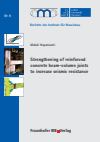Zusammenfassung
The categorized literature review of retrofitting and strengthening methods of reinforced concrete (RC) beam-column joints clarified that non-disruptiveness; practical implementation, ductility and perseverance of lateral resistance as well as economical issues still remain the most challenging aspects of seismically retrofitting the vulnerable existing RC beam-column joints. Current research attempted to observe the seismic design principals of RC frame structures in seismic retrofitting of the vulnerable frames as a strategy of retrofitting based on the capacity design concept. Accordingly, the beam sidesway mechanism was redefined for seismic retrofitting by relocating the beam plastic hinges far enough away from the joints. Consequently, with introducing innovative energy dissipation devices such as Multi Functional Corbels (HMFC) and Harmonica Damper Plates (HHDP), the innovative Retrofitting Techniques 1 and 2 (RT1 and RT2) were proposed. The introduced devices of HMFC and HHDP as a passive energy dissipation system absorb energy through inelastic deformations. The proposed RT1 and RT2 were experimentally evaluated through a series of 3/4-scale beam-column joint specimens under an extremely severe loading history. The excellent performance of retrofitted specimens through the experimental study confirmed that the proposed retrofitting techniques (RT1 and RT2) are able to retain structural integrity with the minimum strength and stiffness degradation. As intended, the energy dissipation capacity was dramatically increased and beam sidesway mechanism was actually formed. Furthermore, a series of non-linear finite element analysis using ATENA was carried out on all reference and retrofitted specimens. The FEM models were validated with experimental outcomes. Subsequently, the validated models were utilized to develop a new simplified method for upgrading based on the advantages of RT1 and RT2. In the new proposed innovative Retrofitting Technique 3 (RT3), HHDP was replaced by Frictional-Bending Damper Plate (HFBDP) which dissipates energy based on friction and bending. The effectiveness and reliability of the proposed RT3 was investigated through a numerical analysis. As confirmed through experimental and numerical investigation, all acceptance criteria of ACI Committee 374 [ACI 374.1-05] were effectively satisfied by the proposed retrofitting techniques.
Abstract
The categorized literature review of retrofitting and strengthening methods of reinforced concrete (RC) beam-column joints clarified that non-disruptiveness; practical implementation, ductility and perseverance of lateral resistance as well as economical issues still remain the most challenging aspects of seismically retrofitting the vulnerable existing RC beam-column joints. Current research attempted to observe the seismic design principals of RC frame structures in seismic retrofitting of the vulnerable frames as a strategy of retrofitting based on the capacity design concept. Accordingly, the beam sidesway mechanism was redefined for seismic retrofitting by relocating the beam plastic hinges far enough away from the joints. Consequently, with introducing innovative energy dissipation devices such as Multi Functional Corbels (HMFC) and Harmonica Damper Plates (HHDP), the innovative Retrofitting Techniques 1 and 2 (RT1 and RT2) were proposed. The introduced devices of HMFC and HHDP as a passive energy dissipation system absorb energy through inelastic deformations. The proposed RT1 and RT2 were experimentally evaluated through a series of 3/4-scale beam-column joint specimens under an extremely severe loading history. The excellent performance of retrofitted specimens through the experimental study confirmed that the proposed retrofitting techniques (RT1 and RT2) are able to retain structural integrity with the minimum strength and stiffness degradation. As intended, the energy dissipation capacity was dramatically increased and beam sidesway mechanism was actually formed. Furthermore, a series of non-linear finite element analysis using ATENA was carried out on all reference and retrofitted specimens. The FEM models were validated with experimental outcomes. Subsequently, the validated models were utilized to develop a new simplified method for upgrading based on the advantages of RT1 and RT2. In the new proposed innovative Retrofitting Technique 3 (RT3), HHDP was replaced by Frictional-Bending Damper Plate (HFBDP) which dissipates energy based on friction and bending. The effectiveness and reliability of the proposed RT3 was investigated through a numerical analysis. As confirmed through experimental and numerical investigation, all acceptance criteria of ACI Committee 374 [ACI 374.1-05] were effectively satisfied by the proposed retrofitting techniques.
Schlagworte
Baumechanik/Baustatik Stütze Betonbau Beton(bewehrt) Balkenträger Verbindung Nachrüstung Verstärkung Seismik Gelenk Verformungsverhalten Konsole Reibung Bauingenieure- Kapitel Ausklappen | EinklappenSeiten
- 270–278 References 270–278

